ALTERATIONS IN PLASMA FIBRINOGEN DURING LIFE EVENTS IN WOMEN
Abstract
Changes in plasma fibrinogen levels were observed in women during pregnancy, labour, postmenopause and after taking oral contraceptives. Mean fibrinogen level was highest at delivery, higher during pregnancy and high in postmenopausal women. Women who ceased menstruation with contraceptive drugs had lower values of plasma fibrinogen than control group.References
Tietz NW. Text book of Clinical Chemistry. W B
Saunders Co, Philadelphia, London, 1986; 1747-49.
Hassan K, Shuaib A, Rana S, Firdous S & Mirza I.
Coagulation parameters in full-term normal pregnancy
during labour. RMJ, 1991; 19(3): 79-82.
Lahteenmaki P, Rasi V, Luukkainen T and Myllya G.
Coagulation factors in women using oral contraceptives
or IUCD immediately after abortion. Am J Obstet
Gynecol, 1981; 141: 175-79.
Meade TW, Haines AP & Imenson JD. Menopausal state
and haemostatic variables. Lancet, 1983; 34: 22-24.
Bahakim H, Galil AM, Gader A & Edress YB.
Coagulation parameters in maternal and cord blood at
delivery. Annals of Saudi Medicine. 1990; 10(2): 149-
Clauss A. Gerinnungs-physiologische schnell- methode
Zur Bestimmung des Fibrinogens. Acta Haematol, 1957;
: 237-47.
Gillman T, Naidoo SS & Hathorn M. Plasma fibrinogen
activity in pregnancy. Lancet, 1959; 2: 70-71.
X. Stirling Y, Woolf L & North WRS. Haemostasis in
normal pregnancy. Thromb Haemost, 1984; 52: 176-82.
Regoeczi E& Hobbs KR. Fibrinogen turnover in
pregnancy. Scand J Haematol, 1969; 6: 175-78.
McDonald MM & Hathaway WE. Neonatal hemorrhage
and thrombosis. Semin Perinatol. 1983; 7: 213-25.
Lee AJ, Lowe GDO, Smith WCS and Pedoe, HT. Plasma
fibrinogen in women: relationships with oral
contraception, the menopause and hormonal
replacement therapy. Br J Haematology, 1993: 83: 616-
Downloads
How to Cite
Issue
Section
License
Journal of Ayub Medical College, Abbottabad is an OPEN ACCESS JOURNAL which means that all content is FREELY available without charge to all users whether registered with the journal or not. The work published by J Ayub Med Coll Abbottabad is licensed and distributed under the creative commons License CC BY ND Attribution-NoDerivs. Material printed in this journal is OPEN to access, and are FREE for use in academic and research work with proper citation. J Ayub Med Coll Abbottabad accepts only original material for publication with the understanding that except for abstracts, no part of the data has been published or will be submitted for publication elsewhere before appearing in J Ayub Med Coll Abbottabad. The Editorial Board of J Ayub Med Coll Abbottabad makes every effort to ensure the accuracy and authenticity of material printed in J Ayub Med Coll Abbottabad. However, conclusions and statements expressed are views of the authors and do not reflect the opinion/policy of J Ayub Med Coll Abbottabad or the Editorial Board.
USERS are allowed to read, download, copy, distribute, print, search, or link to the full texts of the articles, or use them for any other lawful purpose, without asking prior permission from the publisher or the author. This is in accordance with the BOAI definition of open access.
AUTHORS retain the rights of free downloading/unlimited e-print of full text and sharing/disseminating the article without any restriction, by any means including twitter, scholarly collaboration networks such as ResearchGate, Academia.eu, and social media sites such as Twitter, LinkedIn, Google Scholar and any other professional or academic networking site.










